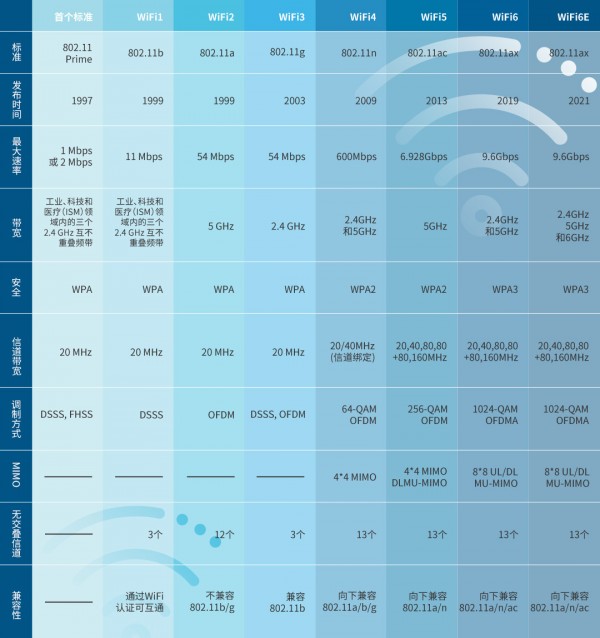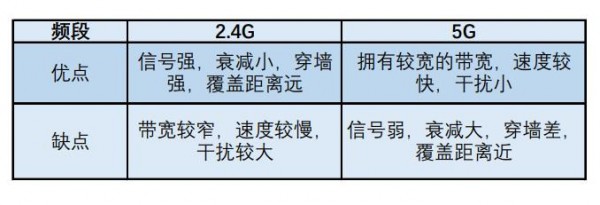Talk about the past and present life of WiFi

When it comes to the development of WiFi, we have to say two organizations: one is the Institute of Electrical and Electronics Engineers (IEEE) and the other is the WiFi Alliance. The full name of the Institute of Electrical and Electronics Engineers is: Institute of Electrical and Electronics Engineers, or IEEE for short, and he defines himself as "the world's largest technical professional association". The IEEE is responsible for the development and maintenance of the 802.11 wireless local area network (WLAN) communication standard, as well as maintaining more than 1,200 technology and communication standards.

The WiFi Alliance (WFA for short) is a commercialization alliance involving many companies and organizations. Includes companies, customers, carriers, and other organizations in the WiFi ecosystem. The purpose of the alliance is to jointly work to achieve and promote the development of open wireless communication technology using standards-based wireless network technology.
That is to say, IEEE is only responsible for writing and specifying the technical specifications that WiFi must comply with. These standards are published in the form of documents, but it is impossible or may not be possible for manufacturers to integrate all the specifications into products, which will lead to uneven product performance and indicators of various enterprises. The Wi-Fi Alliance emerged to develop test plans, services, and certification programs for these broad specifications to drive products through validation to meet the specifications. Build trust in the marketplace by verifying product compatibility and delivering expected performance and functionality.
As a standard organization, IEEE established the 802.11 working group in 1990 to formulate relevant standards for wireless local area networks. Wireless Local Area Network (Wireless Local Area Network, WLAN for short) has two meanings in a broad sense and a narrow sense. In a broad sense, WLAN is a network composed of various radio waves such as laser, infrared and other wireless channels to replace part or all of the transmission medium in wired local area networks; Or a wireless local area network with wireless electromagnetic waves in the 5GHz band as the transmission medium.
With the relatively simple implementation of WiFi technology, its reliability, flexibility, and low cost of communication, it has gradually become the mainstream technical standard of wireless local area networks, and WiFi has now become synonymous with WLAN technical standards.
There are many 802.11 protocols. From 1997 to present, there are more than 2 protocol releases per year on average. This is a disaster for consumers - meaningless numbers and letter combinations are hard to remember. So the WiFi Alliance came up with a new naming system that would make it easier for vendors to name consumers what standards their devices support, service providers to explain what their networks offer, and users to more easily understand which products use which kind of standard.
The 802.11ax technology such as the 6th generation of WiFi is called WiFi 6. WiFi 1/2/3/4/5/6 corresponds to the first version of the protocol, which means that a major supplement to the protocol is made, or a new communication technology is introduced into the protocol.
Features and disadvantages of each generation of WiFi:

IEEE 802.11-1997:
Features: The transfer rate reaches 1 Mb/s or 2 Mb/s per second, and three optional physical layer technologies are specified:
- Scattered infrared operating at 1 Mbit/s
- Frequency hopping spread spectrum technology operating at 1 Mbit/s or 2 Mbit/s
- Direct-sequence spread spectrum technology operating at 1 Mbit/s or 2 Mbit/s
The latter two radio technologies use microwaves for transmission over the 2.4 GHz Industrial, Scientific, and Medical (ISM) band. Its specified data rate is carried by infrared (IR) signals or by frequency hopping or direct sequence spread spectrum (DSSS) radio signals. Infrared transmission, although part of the standard, is not really implemented.
Cons: Poor interoperability due to too many transport options.
IEEE 802.11b (WiFi 1):
Features: Significantly increased speed: data rate of 11 Mbit/s. And achieved a substantial price drop.
Disadvantages: Mutual interference problems with other products operating in the 2.4 GHz band such as microwave ovens, cordless phones, Bluetooth devices.
IEEE 802.11a (WiFi 2):
Features: For the first time, the 5 GHz band has been brought into the standard. Using 52 sub-carrier Orthogonal Frequency Division Multiplexing (OFDM) technology, the data rate is increased to 54 Mbit/s. Anti-interference is better.
Disadvantages: The effective range of transmission is slightly lower, and the penetration of 802.11a signals is not as good as that of 802.11b.

2.4G and 5G WiFi Comparison
IEEE 802.11g (WiFi 3):
Features: Works in the 2.4 GHz frequency band using the same OFDM-based transmission as 802.11a, with a maximum transmission rate of 54 Mbit/s. The hardware is fully backward compatible with 802.11b.
Cons: 2.4 GHz still has interference issues. If there are 802.11b devices in an 802.11g network, it will significantly slow down the entire 802.11g network.
IEEE 802.11n (WiFi 4):
Features: Using MIMO multiple-input multiple-output technology, and bonding 40 MHz channels, the channel bonding technology can bind two adjacent frequency bands together, which can theoretically double the rate. In addition, the MAC layer adds a frame summary function . As a result, the data rate of a single stream is increased to a maximum of 600Mbps, which is 10 times higher than the rate of 802.11g.
Disadvantages: The disadvantage of channel bonding technology is also obvious. Signals will interfere with each other and compete for spectrum resources. At the same time, when using a large bandwidth for transmission, it is necessary to ensure that all the channels to be used are in an idle state. Due to the existence of interference, it will fall back to a lower bandwidth, resulting in a low channel utilization rate.
IEEE 802.11ac (WiFi 5):
Features:
- 802.11ac (the Very High Throughput or VHT standard) uses multi-user MIMO technology (MU-MIMO), which allows one wireless access point to send data to multiple users using the same frequency at a time. MU mode supports up to 4 users, each user supports up to 4 streams, and the total number of streams does not exceed 8.
- Support for larger bandwidth bindings. 802.11ac supports bonding 4 channels of 80MHz bandwidth. Supports higher density modulations up to 256-QAM.
Disadvantages: The availability and number of high-bandwidth channels varies greatly due to the large differences in frequency allocations in the 5GHz band. This will significantly increase the production complexity of equipment manufacturers sell globally.
IEEE 802.11ax (WiFi 6):
Features:
- 802.11ax, also known as High-Efficiency Wireless-HEW, 802.11ax has narrower sub-carrier spacing and longer symbol duration in Orthogonal Frequency Domain Multiplexing (OFDM) to transmit more data within the same channel bandwidth At the same time, it can provide better performance and coverage in outdoor environments and fading scenes.
- 802.11ax uses both the 2.4 and 5GHz bands, enabling WLAN devices to have higher performance and efficiency in both bands, and the 802.11ax task group defines a new 6GHz band.
- Adopt a new modulation scheme and coding set based on 1024-QAM. Downlink and uplink multi-user operation is specified through MU-MIMO and Orthogonal Frequency Division Multiple Access (OFDMA) technologies, increasing data rates while reducing latency. Optimized traffic and channel access with better power management.
Disadvantages: The transmission distance of 802.11ax using the 5GHz frequency band is only half of that of the 2.4GHz signal, and the effective range of 802.11ax signal coverage is roughly similar to that of 802.11ac.
With the popularization of smart terminals and driven by new application requirements such as smart home, metaverse, virtual reality, and high-definition video, the performance requirements for wireless local area networks are also increasing. Wireless networks need to provide users with a more extreme and fast experience, more secure, and more robust overall network performance – enabling automatic deployment, automatic optimization, and automatic troubleshooting.
In the Internet of Things scenario, WiFi technology also faces competition from wireless transmission technologies such as NB-IoT, LoRa, and Zigbee. Compared with NB-IoT, LoRa and other technologies, WiFi technology is in a high position in terms of the number of access terminals, equipment power consumption and other indicators, as well as the price reduction.
However, it has formed a good complement to the wide area network 5G technology. WiFi improves the problems of poor penetration, low coverage, and high power consumption of 5G communication in indoor scenarios. 5G also improves the problem that WiFi cannot achieve long-distance transmission of a large number of devices in outdoor scenarios. The advantages of WiFi technology and WAN technology complement each other and the long-term coexistence is obvious.